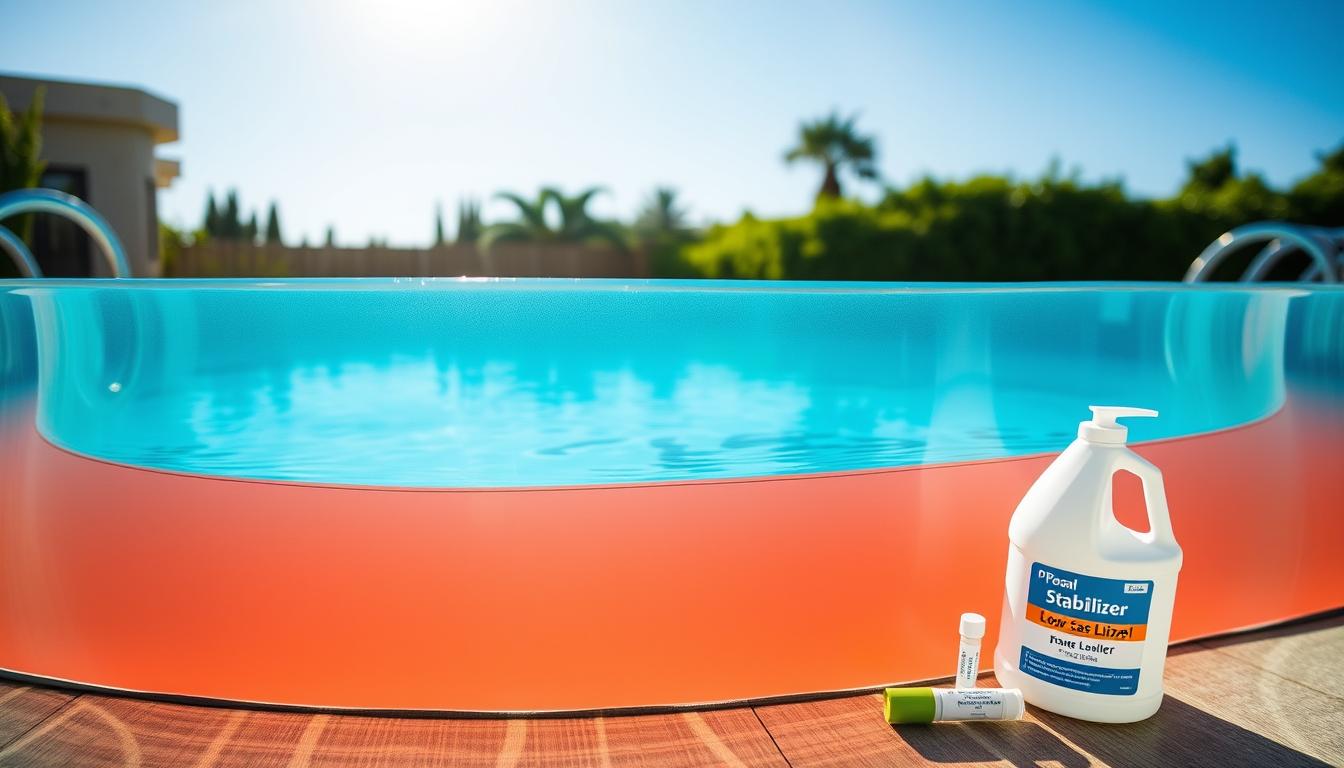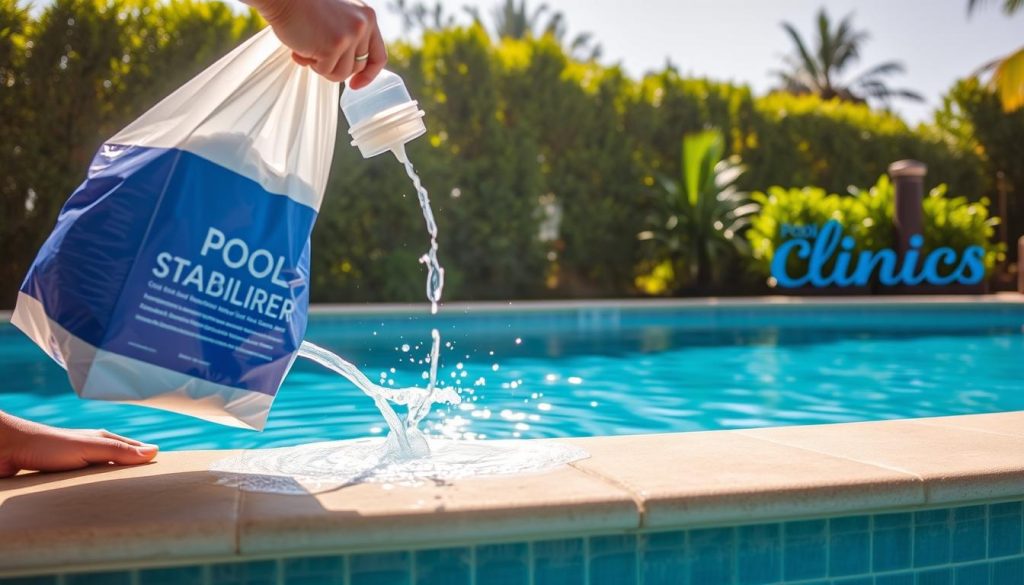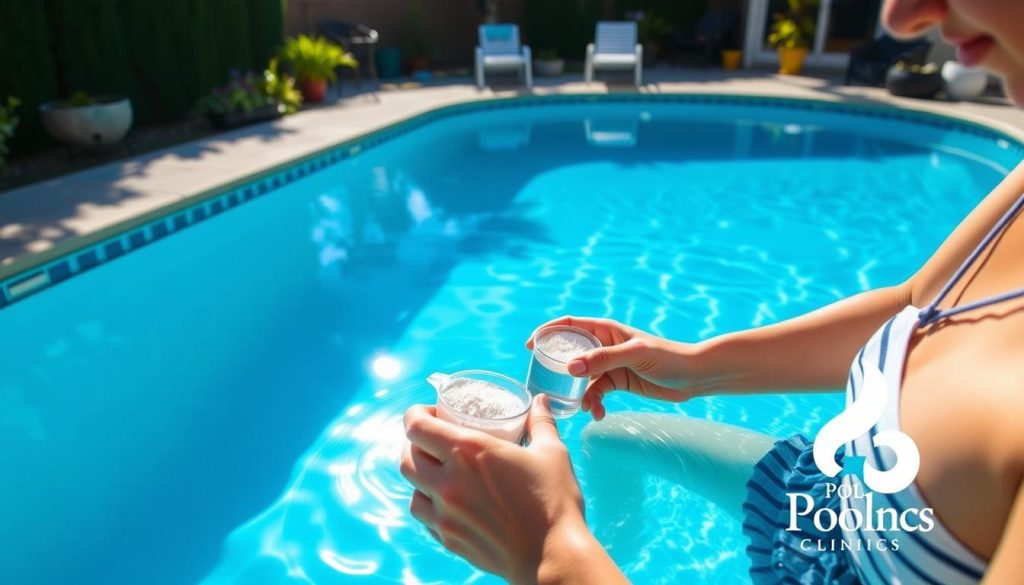
Is your pool water cloudy or green despite regular chlorination? Low stabilizer levels might be the cause. Cyanuric acid protects chlorine from the sun’s UV rays. Without it, chlorine quickly vanishes, leaving your pool open to algae growth.
Good pool water chemistry is key for a great swim. Low stabilizer can cause cloudy water and quick chlorine loss. As pool owners, we must test and adjust stabilizer levels often.
Let’s explore pool stabilizers and why they matter. We’ll learn how to test for low levels and fix them. Understanding cyanuric acid is crucial for keeping your pool in top shape.
Key Takeaways
- Cyanuric acid acts as a pool stabilizer, protecting chlorine from UV degradation.
- Low stabilizer levels can lead to ineffective chlorine, algae growth, and cloudy water.
- Regularly testing stabilizer levels using test kits or strips is essential for pool maintenance.
- The optimal stabilizer range for outdoor chlorine pools is 30-70 ppm, while saltwater pools require 50-70 ppm.
- Adding the right amount of granular or liquid stabilizer can help raise low CYA levels to the desired range.
What is Pool Stabilizer and Why is it Important?
Pool stabilizer, or cyanuric acid, is key for clean, safe swimming pools. It shields chlorine from UV rays, which can quickly break it down. Understanding pool stabilizer helps owners create a healthier swimming environment.
Understanding Cyanuric Acid in a Pool
Cyanuric acid bonds with chlorine, shielding it from UV rays. This keeps chlorine active longer, ensuring consistent sanitization. Without enough cyanuric acid, chlorine dissipates fast, risking swimmers’ health.
How Stabilizer Protects Chlorine from UV Rays
Sunlight can reduce non-stabilized chlorine by 75-90% in two hours. Cyanuric acid acts as chlorine’s sunscreen, absorbing UV rays. This protection allows chlorine to keep fighting bacteria and contaminants.
| UV Exposure Time | Chlorine Reduction Without Stabilizer |
|---|---|
| 2 hours | 75-90% |
Consequences of Low CYA Levels in Your Pool
Low cyanuric acid levels can cause several problems. These include rapid chlorine loss, increased algae, and cloudy water. It may also lead to frequent chlorine additions and higher maintenance costs.
- Rapid chlorine depletion
- Increased algae growth
- Cloudy or murky water
- Frequent need for chlorine additions
- Higher overall maintenance costs
Proper stabilizer levels are crucial for a clean, safe pool. Residential pools need 30-50 ppm of cyanuric acid. The CDC suggests 15 ppm for public pools.
Regular testing and adjustments keep stabilizer levels optimal. This ensures the best possible swimming experience for everyone.
How to Test Stabilizer Levels in Your Pool Water?
Testing stabilizer levels in pool water is vital for a safe swimming environment. Cyanuric acid (CYA) protects chlorine from UV rays. This keeps your pool clean and sanitized.
We’ll explore how to measure CYA levels using test kits and strips. We’ll also discuss the ideal ppm range for optimal pool performance.
Using a Test Kit for CYA Level Measurement
Test kits are reliable for checking stabilizer levels. They involve adding pool water to a solution. Then, you compare the color to a chart.
Follow these steps for accurate results:
- Collect a water sample from your pool, at least 18 inches below the surface and away from any jets or skimmers.
- Add the specified amount of water to the test kit’s sample container.
- Add the appropriate reagent according to the kit’s instructions, and shake the container to mix thoroughly.
- Compare the color of the sample to the kit’s CYA level chart to determine the current stabilizer level in your pool.
Interpreting Test Strips for Stabilizer Levels
Test strips offer a quick way to check CYA levels. They’re less accurate than test kits but more convenient.
To use test strips:
- Dip a test strip into your pool water for the specified amount of time, usually a few seconds.
- Remove the strip and wait for it to change color, which typically takes about 15 seconds.
- Compare the color of the strip to the provided chart to determine the CYA level in your pool.
Test strips can be affected by moisture, heat, and age. Use fresh strips and store them properly for best results.
What PPM Should You Aim for in a Swimming Pool?
The ideal stabilizer range for pools is 30 to 60 parts per million (ppm). This allows chlorine to sanitize effectively while being protected from UV rays.
Levels below 30 ppm may not protect chlorine enough. Levels above 100 ppm can reduce chlorine’s effectiveness.
| CYA Level (ppm) | Impact on Pool Water |
|---|---|
| Below 30 | Insufficient protection for chlorine, leading to rapid UV degradation |
| 30-60 | Optimal range for chlorine protection and sanitization effectiveness |
| 60-100 | Adequate protection, but may start to reduce chlorine’s effectiveness |
| Above 100 | Significantly reduces chlorine’s effectiveness, leading to potential water quality issues |
Regular testing of stabilizer levels ensures a clean, clear pool. Maintain the right ppm range for safe swimming all season long.
How to Raise Cyanuric Acid Levels in Your Pool?
Low cyanuric acid (CYA) levels in pools need attention. The ideal range is 30-50 ppm for outdoor pools using liquid chlorine. This protects chlorine from UV rays, keeping your pool clean and safe.
Choosing the Right Pool Stabilizer Product
Pool stabilizers come in two types: granular and liquid. Granular stabilizers are common and easy to find. They dissolve slowly, making them popular among pool owners.
Liquid stabilizers are less common but can be added directly to pool water. Both types effectively raise CYA levels in pools.

Granular vs. Liquid Stabilizers: Which is Better?
The choice between granular and liquid stabilizers depends on preference and availability. Here’s a comparison of the two types:
| Granular Stabilizer | Liquid Stabilizer |
|---|---|
| More common and widely available | Less common and may be harder to find |
| Dissolves slowly, requiring more time to disperse | Can be added directly to the pool water for faster dispersion |
| May require pre-dissolving in a bucket of water before adding to the pool | No pre-dissolving needed, making it more convenient |
| Generally less expensive than liquid stabilizers | Often more expensive than granular stabilizers |
Step-by-Step Guide to Adding Pool Stabilizer
After choosing a stabilizer, it’s time to add it to your pool. Follow these steps for proper application:
- Calculate the needed stabilizer amount based on pool volume and current CYA levels. Check the product label for dosage instructions.
- For granular stabilizers, pre-dissolve in warm water to help it spread easily.
- With the pump running, pour the solution around the pool’s perimeter for even dispersal.
- Brush the pool to help the stabilizer dissolve and circulate throughout the water.
- Run the pool pump for at least 24 hours to ensure proper circulation.
- Retest CYA levels after 24 hours to confirm they’ve reached 30-50 ppm.
Regular CYA level monitoring maintains ideal balance. This protects chlorine from UV rays, ensuring a clean and healthy swimming environment.
What to Do If Stabilizer Levels Are Too Low?
Low stabilizer levels in your pool can cause major issues. These include higher chlorine demand, algae growth, and potential health risks. It’s vital to act quickly when levels are low.
Testing your pool water regularly helps catch problems early. If you find low stabilizer levels, take steps to restore balance right away.

How Much Stabilizer Should You Add?
Adding the right amount of stabilizer is crucial. Use your pool’s volume and current cyanuric acid (CYA) levels to calculate. For every 10,000 gallons, 13 ounces of granular stabilizer raises CYA by 10 ppm.
Be careful not to overuse stabilizer. Too much can cause “chlorine lock,” making chlorine less effective. Always measure carefully before adding.
To determine the appropriate amount of stabilizer to add, consult the following table:
| Pool Volume (gallons) | Stabilizer Needed to Raise CYA by 10 ppm (ounces) |
|---|---|
| 10,000 | 13 |
| 15,000 | 19.5 |
| 20,000 | 26 |
| 25,000 | 32.5 |
| 30,000 | 39 |
Follow these steps when adding stabilizer:
- Ensure that the pool pump is running to facilitate proper circulation.
- Measure the appropriate amount of stabilizer based on your pool’s volume and the desired increase in CYA levels.
- Slowly pour the stabilizer into the pool, distributing it evenly across the surface.
- Allow the pool pump to run for at least 24 hours to ensure thorough mixing and dissolving of the stabilizer.
- Retest the water after 24 hours to confirm that the CYA levels have reached the desired range (30-50 ppm).
Remember, maintaining the right balance of stabilizer is key to ensuring that your chlorine remains effective and your pool stays clean and safe for swimming.
Monitoring Chlorine Levels After Adding Stabilizer
After adding stabilizer, keep a close eye on chlorine levels. This ensures proper water chemistry and sanitization. Increased cyanuric acid (CYA) levels may require adjusting your chlorine dosage.
Test your pool water regularly to monitor chlorine levels. Keep free chlorine between 3 ppm and 5 ppm for optimal water quality. Use a pool testing kit to measure free and combined chlorine levels.
Maintain pH levels between 7.2 and 7.8 for effective chlorine. This allows chlorine to sanitize the water properly. Low free chlorine and high combined chlorine may indicate chlorine lock.
When to Seek Help from the Pool Store
Consult a pool professional if chlorine levels stay low or water remains cloudy. Pool stores can help balance your water chemistry. They can also troubleshoot any issues that arise.
You may need to shock your pool to break chlorine lock. This involves adding a high dose of chlorine to eliminate contaminants. Shock your pool weekly during peak season and biweekly in off-season.
| Situation | Action |
|---|---|
| Low free chlorine level (below 3 ppm) | Adjust chlorine dosage and monitor levels closely |
| High combined chlorine level (above 3 ppm) | Shock pool to break chlorine lock and restore sanitization |
| Cloudy water or persistent issues | Consult a pool professional for expert advice and assistance |
In extreme cases, you may need to partially drain and refill your pool. This can help with high cyanuric acid levels. Always consult a professional before attempting this complex process.
Monitor chlorine levels closely and seek help when needed. This ensures your pool stays safe, clean, and enjoyable for everyone.
Pool owners aim for clear, inviting swimming environments. Yet, mistakes in pool maintenance are common, especially with stabilizer levels. Let’s explore some common pitfalls and how to avoid them.
We’ll help you keep your pool sparkling throughout the swimming season. Your pool can remain a refreshing oasis with proper care.
Overusing Stabilizers: What You Need to Know
Pool owners often overuse stabilizers like cyanuric acid (CYA). CYA protects chlorine from UV rays. But too much can cause chlorine lock.
Chlorine lock happens when free chlorine to CYA ratio exceeds 7.5%. This makes chlorine less effective at cleaning water. Keep CYA at 30-50 ppm for regular pools.
For saltwater pools, maintain CYA levels between 60-80 ppm. This balance ensures effective sanitization without overdoing it.
Ignoring Water Chemistry: The Impact on Pool Care
Neglecting overall water chemistry is another common error. pH, alkalinity, and calcium hardness all affect pool health. Imbalanced water can cause various problems.
These issues include scaling, staining, and equipment corrosion. Swimmers may experience eye and skin irritation. Sanitizers become less effective in unbalanced water.
- Scaling and staining of pool surfaces
- Corrosion of equipment and fixtures
- Eye and skin irritation for swimmers
- Reduced effectiveness of sanitizers
Test and adjust your pool water regularly. Maintain these ideal ranges:
| Parameter | Ideal Range |
|---|---|
| pH | 7.4-7.6 |
| Total Alkalinity | 80-120 ppm |
| Calcium Hardness | 200-400 ppm |
How to Avoid Algae Growth by Maintaining Proper CYA Levels
Low stabilizer levels can cause rapid chlorine loss. This creates perfect conditions for algae growth. Outdoor pools can lose half their chlorine in 17 minutes under strong sunlight.
Proper CYA levels extend chlorine effectiveness by 3-5 times. This helps prevent algae blooms in your pool. Regular testing is key to maintaining this balance.
Remember, the key to a healthy, algae-free pool is regular testing and adjusting of both CYA and chlorine levels. Aim for a CYA range of 30-50 ppm and a free chlorine level that is 7.5 percent of your CYA reading. For example, with 40 ppm CYA, target a free chlorine level of 3 ppm.
Avoid these common pool maintenance mistakes. Focus on proper stabilizer use, water chemistry, and algae prevention. You’ll enjoy a clean, safe pool all season long.
Tips for Maintaining Optimal Stabilizer Levels
Keeping your pool water balanced and safe is crucial. Regular testing of cyanuric acid (CYA) levels helps maintain optimal conditions. The ideal CYA range is 30-50 ppm, protecting chlorine from UV rays.
Regular Testing: Keeping Your Pool Water Balanced
Test pH, alkalinity, and chlorine weekly. Aim for a pH of 7.4 to 7.6 and total alkalinity of 80-120 ppm. This ensures comfortable swimming conditions.
Regular checks help identify and fix imbalances quickly. This prevents small issues from becoming big problems.
Best Practices for Pool Owners to Manage Stabilizer
Use a reliable test kit and follow a consistent maintenance schedule. Keep accurate records of chemical levels and adjustments to track trends.
Choose the right pool stabilizer product. Always follow the manufacturer’s instructions when adding it to your pool.
Understanding the Role of Alkalinity and Acid Levels
Alkalinity acts as a buffer, preventing sudden pH changes. The ideal total alkalinity range is 80-120 ppm.
Maintain pH between 7.4 and 7.6 for effective chlorine sanitization. Regular monitoring creates a balanced environment for stabilizer to work effectively.
Quick Navigation
- What is Pool Stabilizer and Why is it Important?
- How to Test Stabilizer Levels in Your Pool Water?
- How to Raise Cyanuric Acid Levels in Your Pool?
- What to Do If Stabilizer Levels Are Too Low?
- Monitoring Chlorine Levels After Adding Stabilizer
- Common Mistakes in Pool Maintenance Related to Stabilizer
- Tips for Maintaining Optimal Stabilizer Levels







